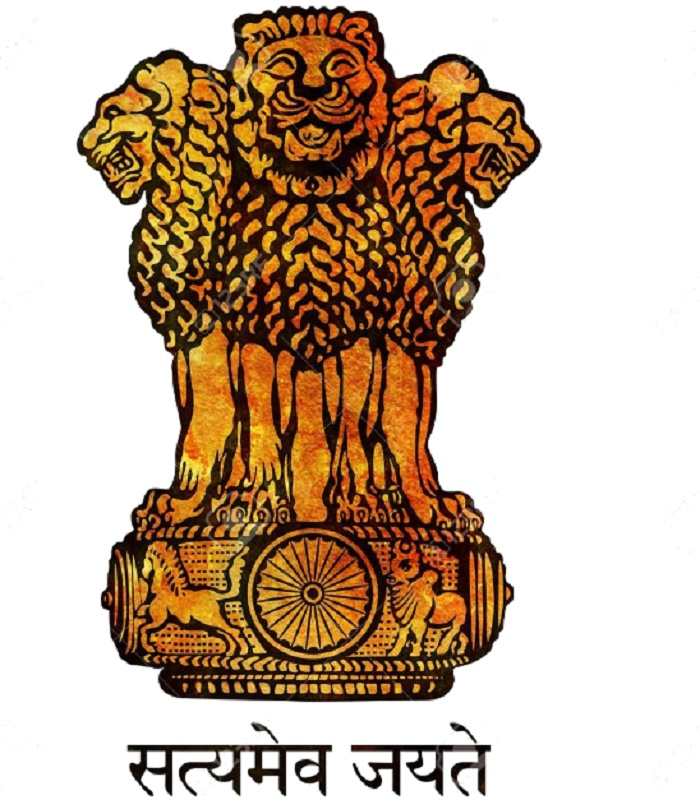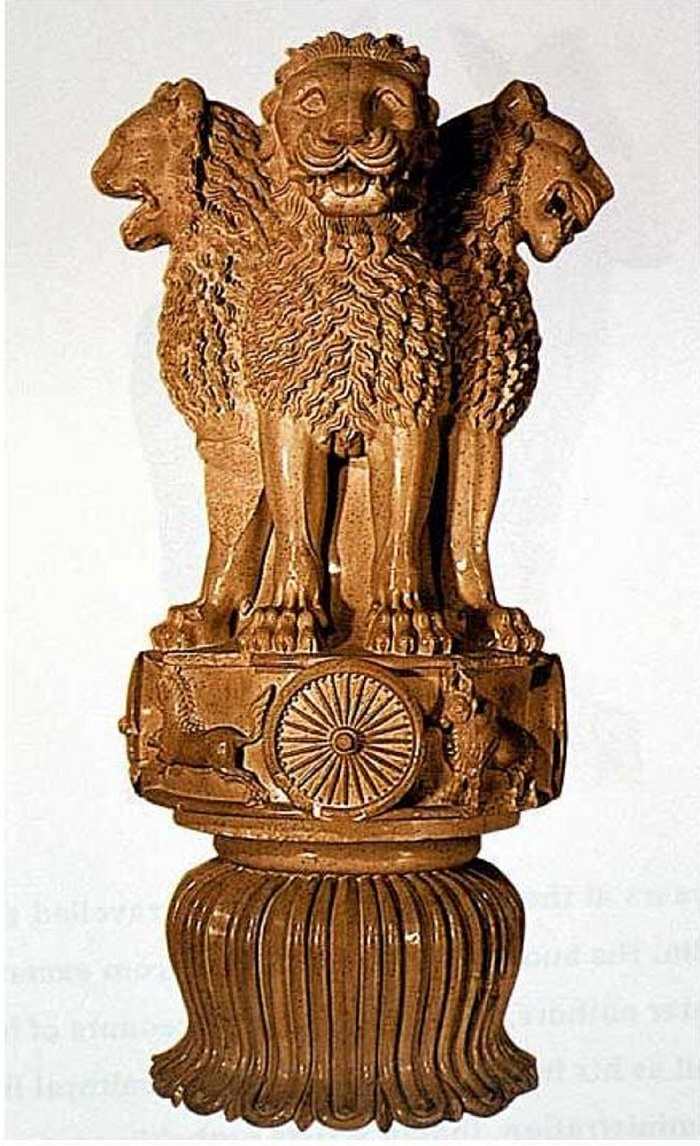Representative of: The Republic of India
Based on: The Lion Capital of the Ashoka Pillar in Sarnath, Uttar Pradesh
Motto: Satyameva Jayate/ Truth Alone Triumphs
Adopted by: Madhav Sawhney
Adopted on: January 26, 1950

Image Credit: https://drt.gov.in/img/logonew.png
An emblem by definition is “a heraldic device or symbolic object as a distinctive badge of a nation, organization, or family”. The national emblem of a country is a seal that is reserved for official use by the state. For a country, the national emblem is a symbol of authority and represents the basis of its constitutional philosophy.
The national emblem of India is an adaptation of the Lion Capital atop the Ashoka Pillar of Sarnath, Uttar Pradesh, and is combined with the National Motto Satyameva Jayate. The Lion Capital was adopted as the National Emblem of India on January 26, 1950. It was a declaration of the newly acquired Republic status of India. The National Emblem is used for official purposes only and demands sincere respect from the citizens of India. It acts as the official seal for all national and state government offices and is the compulsory part of any letterhead used by the government. It features prominently on all currency notes as well as on diplomatic identification documents like the passports issued by the Republic of India. The national Emblem is the symbol of sovereignty for India.
Description
The National Emblem is the graphic representation of the Lion Capital that originally graced the top of the Ashok Stambh or Ashoka Pillar at Sarnath, along with the National Motto written below it. The Lion Capital crowning the Ashok Pillar is carved out of a single block of yellow sand stone and features four Asiatic Lions sitting back to back, but the two dimensional representation of National Emblem depicts only 3, the fourth lion is hidden from view. The four lions stand on a short cylindrical base that has four Ashok Chakras corresponding to each lion bust and reliefs of four more animals in between them – the lion, the bull, the elephant and the galloping horse. In the 2D form of the National Emblem, only one Ashok Chakra is visible in the front with the galloping horse on the left and the bull on the right of it.The Ashok Chakra is actually a form of the Buddhist Dharma Chakra. The actual Lion Capital sits on an inverted lotus abacus which has not been included in the National Emblem representation. Instead, below the representation of the Lion Capital, the words Satyameva Jayate is written in Devnagari Script, which is also the National Motto of India. The words are a quote from Mundaka Upanishad, the last and most philosophical of the four Vedas and is translated as ‘Truth alone triumphs’.

History
The history behind the National Emblem’s inspiration dates back to the 3rd Century BC. The third Mauryan Emperor, Ashoka was a great conqueror and he established the first true empire in India. Emperor Ashoka embraced Buddhism after witnessing the endless bloodshed his quests wrought over the country. Thereafter, instead of conquests and wars, he made non-violence, spiritualism, compassion and peaceful co-existence the cornerstones of his administration. He erected a number of sculptures and stone carvings throughout his kingdom to preach the tenets of Buddhism among his people. The Lion Capital was erected by Mauryan Emperor Ashoka during the year 250 BC to mark the spot where Buddha imparted his knowledge of Dharma to his five disciples, who in turn spread the great monk’s teachings all over the world. Many such other pillars were erected by the Emperor but most of them contain a single animal on top.
The pillar had originally sunk into the ground and wasn’t visible. German-born civil engineer Friedrich Oscar Oertel started excavation of the area following the accounts of Chinese travellers during the medieval age. The excavations started in December 1904 and ended in April 1905. He unearthed the Ashoka Pillar of Sarnath in March 1905 and the whole pillar was found in three sections. The topmost Lion Capital was found intact and is currently displayed in the Sarnath Museum.
Symbolism
The Ashoka Pillar and the Lion capital on top of it were built by Emperor Ashoka to mark the spot where Buddha first disseminated his ‘Bodhi’ to disciples. His gospel of peace, tolerance and emancipation from worldly attachments became the basis of life of penance when he embraced Buddhism. By adopting this sculpture as the National Emblem, the Republic of India recognizes its allegiance to the philosophies of Buddha, attested the positive changes Ashoka brought to his kingdom and reaffirms its commitment towards upholding peace and tolerance.
The four lions of the capital joined back to back symbolize stress on equality and justice in all spheres of life. The four lions are also representative of the four core spiritual philosophies of Buddha since Buddha himself is symbolized as a lion. The three lions visible on the capital’s representation in the National Emblem signify Strength, Courage and Confidence. It also signifies constant vigilance over all four directions. The cylindrical base below the lions further upholds certain symbolism. The circular wheel in the middle is a form of Buddhist Dharma Chakra and is known as the Ashok Chakra after the emperor who popularized it. The 24 spokes of the Chakra represent the number of hours in a day, and portray the passage of time. The spokes signify moving forward in life and thus one avoids stagnation of the mind. The four animals depicted alternatively between the chakras are regarded as the guardians of four directions - the lion for the north, the elephant for the east, the horse for the south and the bull for the west. These animals appear to be rolling the chakras along the cylinder’s circumference. In some Buddhist texts, all these animals have been referred to as symbols for Buddha himself and the may be deduced as him carrying forward the tenets of Dharma. In yet another interpretation, these four animals represents the different stages of Lord Buddha’s life. The elephant represents the conception of Prince Siddhartha (Queen Maya dreamt of an elephant entering her womb). The bull is the representative of Prince Siddhartha in his youth while the horse depicts Siddhartha renouncing his royal life in search of Bodhi. The lion is the depiction of Siddhartha attaining Bodhi under the Peepal tree and his transformation as Buddha.
The phrase Satyameva Jayate is from a verse of the Mundaka Upanishad that is embedded in the Atharva Veda, one of the four primary Hindu scriptures. The motto is taken from the well-known mantra 3.1.6which is as follows –
Satyameva jayate nanrtam
Satyena pantha vitato devayanah
yenakramantyrsayo hyaptakama
yatra tat satyasya paramam nidhanam
This verse may be translated in English as “Only truth prevails, not untruth; by the path of truth is laid out, the Divine way, on which the sages of yore, fulfilled in their desires, attain the supreme treasure of Truth.”
The verse and the National Motto adopted thereof proclaims that as a nation, India is committed towards upholding the truth above all else.
Significance
The national emblem serves as a source of inspiration to over 1 billion Indians evoking a sense of pride in their hearts. The emblem is the signature of authority of the Government of India and thus its misuse by unauthorized persons needs to be prevented. State Emblem of India (Prohibition of Improper Use) Act, 2005, prohibits improper use of State Emblem of India for professional and commercial purposes and for matters connected therewith or incidental thereto. Any person found guilty of such disrespect may face imprisonment upto 2 years and monetary fine that may go upto 5000 rupees.
The three lions stand tall and proclaim the country’s commitment towards peace, justice and tolerance. In its structure the Emblem accentuates the fact that India is a confluence of cultures, its heritage is seeped into the austere spiritual doctrines of Buddhism along deep appreciation for the philosophical canons from the Vedas.



